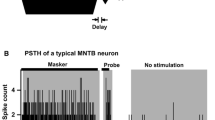Summary
-
1.
The influence of the direction of the sound source on the response patterns of neurons in the auditory system ofLocusta migratoria has been investigated electrophysiologically. The new types C1, E, F, and I are introduced.
-
2.
The F-neuron reacts very sharply to a change in the direction of the sound source (Figs. 8 and 9), the C1-neuron shows no reaction to a change in the position of the sound source. Between these two extremes there are some neurons, which react to a change in direction in a graduated way.
-
3.
The response patterns of the C-neuron depend upon the position of the sound source. This dependence holds for the whole range of intensity and frequency to which this neuron responds (Pig. 17).
-
4.
The E-neuron signals only the direction of high level sounds (Pig. 11), the B-neuron signals only the direction of low level sounds (Pigs. 15 and 16). The G-neuron reacts only to sounds of middle frequencies and intensities (Pigs. 12, 13, and 14).
-
5.
The interactions between the neurons of both sides of the nerve cord can be shown by the rotation of the sound source before and after the destruction of one tympanum. The neuronal mechanisms which are responsible for the dependence of single neurons on the direction of the sound source are discussed.
Zusammenfassung
-
1.
Der Einfluß der Schallrichtung auf die Antwortmuster der akustischen Neuronentypen vonLocusta migratoria wird elektrophysiologisch untersucht. Es werden neue Neuronentypen (C1, E, F und I) beschrieben.
-
2.
Das F-Neuron antwortet auf unterschiedliche Schallrichtungen sehr gut (Abb. 8 und 9), die Antworten des C1-Neurons dagegen sind unabhängig von der Schallrichtimg. Zwischen diesen beiden Extremen gibt es Neuronen, die die Richtung in abgestufter Weise verarbeiten.
-
3.
Die Antwortmuster des C-Neurons zeigen eine deutliche Richtungsabhängigkeit. Dies gilt für den gesamten Prequenz- und Intensitätsbereich, der von diesem Neuron beantwortet wird (Abb. 17).
-
4.
Von dem E-Neuron wird nur im oberen Intensitätsbereich eine genaue Richtungsverarbeitung vorgenommen (Abb. 11). Das G-Neuron verarbeitet die Schallrichtung nur im mittleren Frequenz- und Intensitätsbereich (Abb. 12–14). Die Richtungsbestimmung schwellennaher Laute wird vom B-Neuron durchgeführt (Abb. 15 und 16).
-
5.
Durch Drehung der Schallquelle und gleichzeitiger Ableitung vor und nach der Ausschaltung eines Tympanalorgans können mögliche Interaktionen zwischen ren Neuronen beider Seiten des Bauchmarks sichtbar gemacht werden. Die neurodalen Mechanismen, die die Richtungsabhängigkeit der einzelnen Neuronen hervornufen, werden diskutiert.
Similar content being viewed by others
Literatur
Adam, L. -J.: Neurophysiologie des Hörens und Bioakustik einer Feldheuschrecke (Locusta migratoria). Z. vergl. Physiol.63, 227–289 (1969).
Autrum, H., Schwartzkopff, J., Swoboda, H.: Der Einfluß der Schallrichtung auf die Tympanal-Potentiale vonLocusta migratoria. Biol. Zbl.80, 385–402 (1961).
Kalmring, K.: Akustische Neuronen im Unterschlundganglion der WanderheuschreckeLocusta migratoria. Z. vergl. Physiol.72, 95–110 (1971).
Kalmring, K., Rheinlaender, J., Rehbein, H. G.: Akustische Neuronen im Bauchmark der WanderheuschreckeLocusta migratoria. Z. vergl. Physiol.76, 314–332 (1972).
Katsuki, Y., Suga, N.: Neural mechanism of hearing in insects. J. exp. Biol.37, 279–290 (1960).
Rheinlaender, J., Kalmring, K., Römer, H.: Akustische Neuronen mit T-Struktur im Bauchmark von Tettigoniiden. J. Comb. Physiol.77, 208–224 (1972).
Rowell, C. H. F., McKay, J. M.: An acridid auditory interneurone. I. Functional connexions and response to single sounds. J. exp. Biol.61, 231–245 (1969).
Rowell, C. H. F., McKay, J. M.: An acridid auditory interneurone. II. Habituation, variation in response level and central control. J. exp. Biol.51, 247–260 (1969).
Suga, N.: Central mechanism of hearing and sound localization in insects. J. Insect Physiol.9, 867–873 (1963).
Suga, N., Katsuki, Y.: Central mechanism of hearing in insects. J. exp. Biol.38, 545–558 (1961).
Author information
Authors and Affiliations
Additional information
Mit Unterstützung der Deutschen Forschungsgemeinschaft; aus dem Programm des SFB 114 (Bionach).
Rights and permissions
About this article
Cite this article
Kalmring, K., Rheinlaender, J. & Römer, H. Akustische Neuronen im Bauchmark vonLocusta migratoria . J. Comp. Physiol. 80, 325–352 (1972). https://doi.org/10.1007/BF00694845
Received:
Issue Date:
DOI: https://doi.org/10.1007/BF00694845




